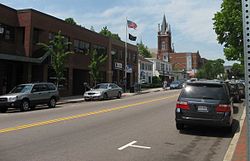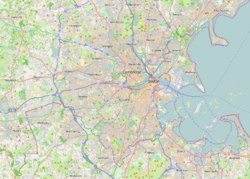This article contains promotional content. (February 2019) |
Watertown, Massachusetts | |
|---|---|
City | |
 Watertown's Main Street, facing westward | |
| Motto(s): In pace condita (Latin) "Founded in peace" | |
 Location in Middlesex County in Massachusetts | |
| Coordinates: 42°22′15″N 71°11′00″W / 42.37083°N 71.18333°W | |
| Country | United States |
| State | Massachusetts |
| County | Middlesex |
| Settled | July 1630 |
| Incorporated | September 7, 1630 |
| Government | |
| • Type | Council-manager |
| • City Manager | George Proakis |
| Area | |
• Total | 4.12 sq mi (10.68 km2) |
| • Land | 4.00 sq mi (10.35 km2) |
| • Water | 0.13 sq mi (0.33 km2) |
| Elevation | 36 ft (11 m) |
| Population (2020) | |
• Total | 35,329 |
| • Density | 8,841.09/sq mi (3,413.41/km2) |
| Time zone | UTC−5 (Eastern) |
| • Summer (DST) | UTC−4 (Eastern) |
| ZIP Code | 02472 |
| Area code | 617/857 |
| FIPS code | 25-73440 |
| GNIS feature ID | 0612401 |
| Website | www.watertown-ma.gov |
Watertown is a city in Middlesex County, Massachusetts, United States, part of Greater Boston. The population was 35,329 in the 2020 census. Its neighborhoods include Bemis, Coolidge Square, East Watertown, Watertown Square, and the West End.
Watertown was one of the first Massachusetts Bay Colony settlements organized by Puritan settlers in 1630. The city is home to the Perkins School for the Blind, the Armenian Library and Museum of America, and the historic Watertown Arsenal, which produced military armaments from 1816 through World War II.
- ^ "2020 U.S. Gazetteer Files". United States Census Bureau. Retrieved May 21, 2022.




